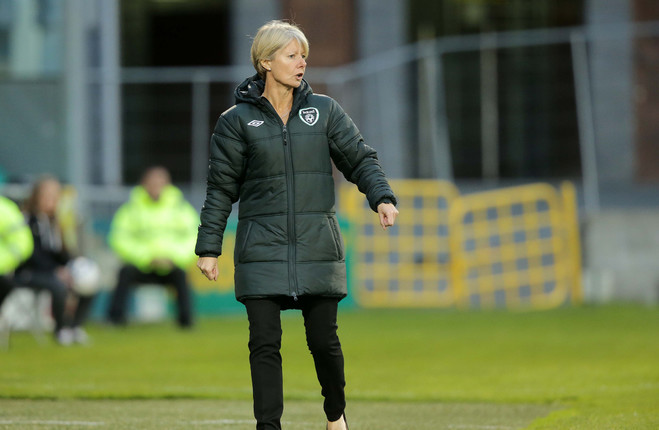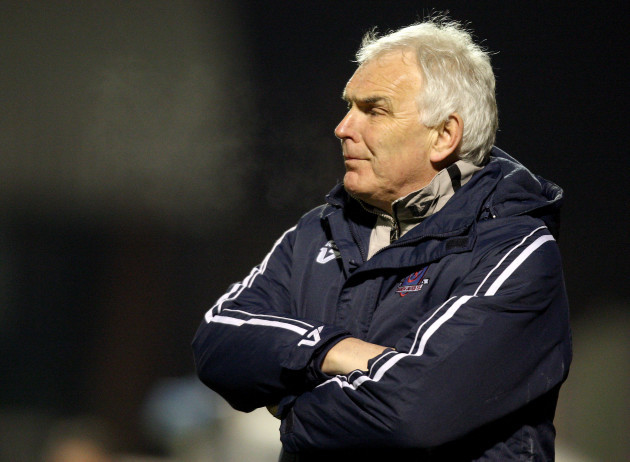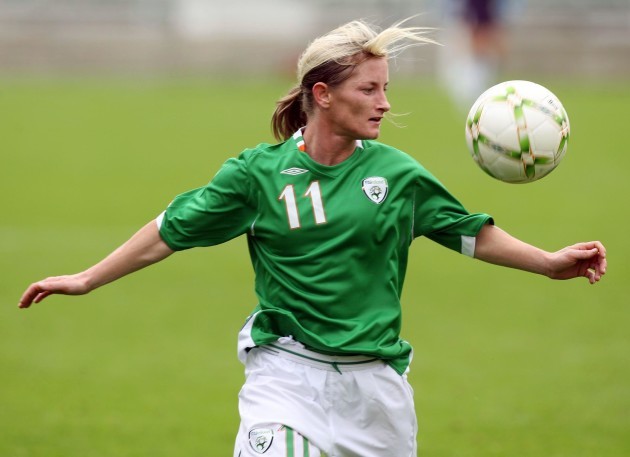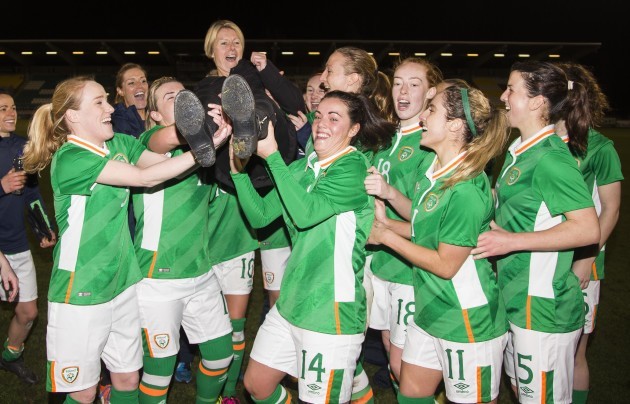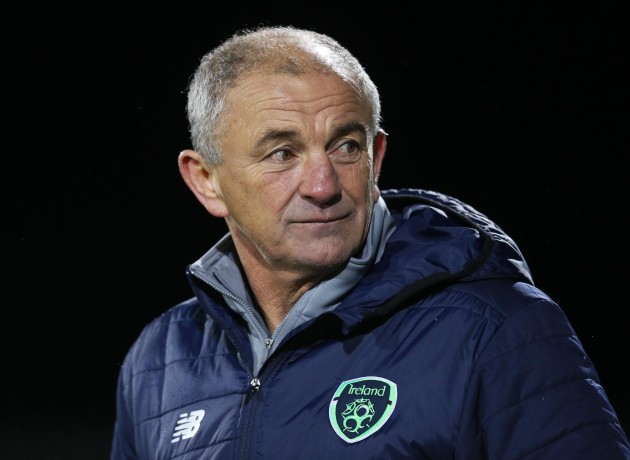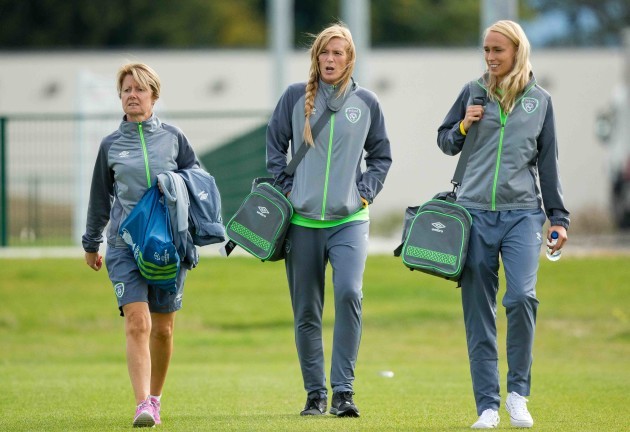DURING THE WEEK, a historic deal was announced that will see Ireland players of both sexes earn equal pay at international level for the first time.
Female stars previously earned €500 per appearance, while male players were given €2,500.
It is understood that the men’s footballers agreed to reduce their fee in order to be in line with the women’s increase to €2,000.
It is not life-changing money, but it is a significant moment nonetheless, and one that everyone from Taoiseach Micheál Martin to tennis legend Billie Jean King was praising during the week.
It is another sign of progress for women’s football in Ireland and while there is still a long way to go, it is the latest barrier to have been removed.
Many people have been working tirelessly behind the scenes for years to pave the way for such developments — and while it is impossible to mention them all, one person who certainly deserves credit is Sue Ronan.
The 57-year-old has had an immense passion for football since childhood, ultimately helping to promote the women’s game at various levels for decades.
In that time, she has witnessed significant changes in the way women’s football is perceived in Ireland.
Of her childhood, she recalls: “I remember standing at the gate in the garden looking at the boys in the street and wanting to play, but not knowing whether I was welcome or how to go about it. That evolved and I was invited to play. I found my niche and was accepted.
“I obviously could play and had a bit of skill. They were my first memories really of playing and then it went on to coming home from school every day and just wanting to play football. You just left everything, had your dinner — I don’t even remember homework, I’m sure it was difficult to get me to do it — and out you went playing with the boys.”
Growing up in Crumlin, watching her older brother and father play was a big influence, while Ronan was a big fan of Arsenal FC, although she notes that all her role models, from David O’Leary and Liam Brady to more modern figures such as Thierry Henry and Arsene Wenger, were men. Ireland was also not an especially welcoming environment for aspiring female footballers at the time.
“I went to Loreto College and there was no football for girls. It was literally basketball or hockey. It was as if there was no such thing as football.
“But during my secondary school years, there were street leagues. It was literally one street plays the next. I would have been seen as part of our street and part of our team. There was probably about six or seven of us between the boys and myself that played. My street wanted me to be on the team but I wasn’t allowed to play because I was a girl. So that was my first awareness of: ‘There’s something not right here, why can I not play?’ Obviously, you just accepted it in those days.”
Ronan’s father was good friends with Richard Dunne’s dad, Dick, an ex-Shamrock Rovers player. Through that connection, it was discovered that another member of the Dunne family was running a women’s team. And that’s how Ronan ended up signing for Cherrywood United, after finishing her Leaving Cert. A year later, she joined Packard, impressing to the extent that in 1988, she was called up to the Irish team for the first time.
Ronan subsequently joined Dublin Women’s Soccer League outfit Welsox (who in 1995 became Shelbourne) and began to establish herself as one of the top players in the country.
In total, she earned 22 caps for Ireland, starting out as a striker under Fran Rooney before Mick Cooke subsequently converted her into a deep-lying midfielder as she got older.
“I remember my debut and the shock I got at the level of the game, the speed of the team we were playing, Sweden, who were one of the top sides in the world. In those days, because the resources were so small, we could only bring 13 players [to Sweden]. Fran chose not to bring a reserve goalkeeper.
“Of course, five minutes into the game, the goalkeeper got injured. And that’s how Sue Hayden ended up going in goal and she ended up having a good career, she would have been the goalkeeper before Emma Byrne. She was a real role model for Emma, a fantastic goalkeeper.
“All I remember is it was a really warm day and just chasing shadows. I don’t even remember touching the ball, that’s how little of it we had. We lost 2-0, but it felt like more.
“I played a couple of years more, then I was out for about a year with an injury. The first female coach we had [Linda Gorman], I never got into her squad because she had a big trial to look at everybody. I wasn’t available and anyone that wasn’t available didn’t subsequently get called up. She was only there for a year anyway.”
She continues: “The national teams were looked after by the WFAI [Women's Football Association of Ireland], who were effectively volunteers. They administered the leagues around the country. They had to fundraise to send us to Sweden and to get us gear. We got nothing from the FAI back then.
“Tony O’Neill was the FAI’s general secretary. He subsequently heard through Uefa that underage competitions were going to be introduced in the mid to late 90s. So the FAI decided ‘we need to take over the national teams and there are going to be more than one’. Make sure they’re better prepared or have some sort of financial support. I think it came after a heavy defeat, they said we needed to step out of competition for a couple of years in order to prepare.
“Unfortunately, it also coincided with the time Uefa restructured the seeding and the qualification system. We ended up in tier 2. So only the teams in tier 1 could qualify and the teams in tier 2 were playing for promotion. So we had to slot into tier 2 and were there until the mid-00s when Noel King got us promotion. It was a shame because we were definitely better than that.”
While the team weren’t always given adequate support, Ronan still managed to excel, winning the FAI Women’s Player of the Year award in 1993.
“I could sort of read the game and maybe I was better at threading those passes through to our forward players. Olivia O’Toole definitely was the dynamo on the ball, skipping by players and making things happen.
“It’s just unfortunate the level was way below what other countries were playing at.
“It was similar in most sports, there was no such thing as sports scientists. So people probably didn’t know what the inside of a gym looked like.
“In preparing for one year of qualification, we used to train every Saturday morning in the Institute in Marino. There was often a bit of a conflict. There was a side gate into the GAA facility. The Gaelic team would often be looking to use the same pitch and it seems they had some relationship with the college to use the facilities as well, so there was often a ‘who gets here first to use the pitch’ type thing.
“Mick then took it up a notch in wanting to get us fit. You were probably training once a week with your clubs. maybe twice a week, but nothing like the level you needed to be at for international football. So he had us meet in Phoenix Park every week.
“I don’t know how long we did it for, but it was the best training I ever did. I was fit with my club for nearly two years after it. You built up such stamina and strength in your legs.”
Cooke was also an important influence in another sense. In the mid-90s, Ronan and her Irish teammates were given the chance to undertake an A coaching licence (or ‘preliminary’ as it was known then).
“We were housed in a teacher training college up in Drogheda — you didn’t have money to be staying in hotels. Mick was obviously looking after the national team, he was also working full-time, he was a prison officer and he wanted somebody that he trusted and felt could do the job to look after the U16s.
“He asked Marie Price Bolger and me to come in and help. So I was doing that while I was playing. Perhaps he saw something in me as a senior player in the national team. I’d been captain of my club. I was able to ask questions. I understood the game. I could question him in training and encourage my teammates.”
Eventually, Ronan agreed to become Cooke’s assistant with the Ireland U18s — a move that would require her to finish playing.
The Dubliner then graduated to Ireland U19s coach, spending 10 years in the role. Ireland routinely got through the first round but could not get further than the elite phase of qualification.
“We always came up against the really strong teams. In the early days of playing England, the games were always very close. But from the mid-00s when they pumped money into the game and they had technical talent centres, they restructured their pyramid, they just went up to a different level. And every time we played them after that, it was a struggle, you could see how they improved physically.”
Ronan initially coached on a voluntary basis in her spare time, combining football commitments with a job at Crumlin Children’s Hospital.
However, after the FAI’s Genesis report recommended the implementation of a women’s department, in the mid-2000s, Ronan secured a full-time role as national coordinator, while positions were also created for women’s football development officers.
“A lot of the [women's] clubs were going against the men’s and the boys’ games in terms of looking for facilities, coaches, referees. The traditional season was September to May, so the women’s season really had to fit in during the summer months.
“So that was a big problem for [women's] national teams. The first-round knockout groups took place in September and you had players that were fit and on top of their game. But by the time of the second round in March or April, most of them were doing nothing for the whole winter months. That, along with the fact that you were playing stronger teams, you were up against it all the time in terms of trying to qualify.
“But when more resources were put into the game in the FAI, when there was a women’s unit and development officers that could go out and try to get things going around the country [the situation improved]. We started winter training camps, which effectively was the precursor to the current emerging talent programme with girls in centres of excellence in various venues. In those days as well, elite players wouldn’t have been as widespread around the country as they are now. They would have been predominantly where the bigger leagues were — Cork, Dublin, Donegal.
“More and more leagues started with more numbers coming into the game. We also introduced grassroots programmes, so we had young girls now playing the game and falling in love with it because they weren’t forced to join a summer camp. You might [previously] have two or three girls with 100 boys and they weren’t having a good experience.
“They were enjoying the game playing with their own peer group. So there were more demands for clubs and leagues to set up teams. As a result, leagues started to grow, change and elongate.”
In 2010, after Noel King switched from coaching the senior women’s team to Ireland U21s, Ronan successfully applied to fill the former role.
“Some of the players were coming to the end of their careers. We didn’t have a great underage structure at the time here either. It was very difficult to pluck young girls that were ready and put them into the national team.
“It was definitely a team where a lot of players would have played with Noel for a long time. We also didn’t even have a national league here until 2010. So there were a lot of players from abroad that Noel had brought in. He felt they were better than what was here and they probably were back then.
“And when I took the national team on, I was also still responsible for player development. So I wasn’t a full-time coach. It was half and half with the two roles. I had a responsibility to grow the domestic game here as well. And also, we were hitting a recession, so budgets were severely cut and it wasn’t an ideal time to come in.
“But there were a lot of good players here that were starting to come through. We’d just won a silver medal in Europe with the U17s in 2010. Those players deserved an opportunity. And if they didn’t get that, they could have been lost to the game.”
Though Ronan ultimately didn’t achieve her aim of becoming the first coach to oversee Ireland’s qualification for a major tournament at women’s senior level, the coach believes she left the team in a stronger position than she found it. Talented teenagers such as Denise O’Sullivan and Megan Campbell, who have since gone on to greater things, were among the players introduced into the setup.
“We were third seeds back then like we are now. We were always targeting that second place. The first seed, the likes of Germany, were so far ahead of the others.
“Most of our players were amateur. There were only one or two that were playing professionally.
“And we were a bit up and down in those days. We had some really great results, great performances. Then we’d nearly shoot ourselves in the foot by having a poor game against a team you’d expect to do better against. Whether it was the pressure, I don’t know, but I don’t think I had a lot of luck with injuries as well.
“I introduced a lot of professionalism around the structures. I introduced home-based training sessions. They didn’t take off as well as they could have, there were various reasons for that, finance being one of them. Clubs not really wanting to release their players was another issue.
“So there were a lot of issues that have been overcome since. The women’s game has been embraced more in general, not only by the FAI but clubs, leagues, the public and even the media. And in terms of the FAI, they’ve got their act together too in terms of the promotion around the game that wasn’t always there for various reasons.
“Colin Bell came in [as manager], he was the first full-time coach with the national team. And that’s the way it should be.
“There are resources around it now that I would have looked for back in the day, but unfortunately the finance wasn’t there. You’ve all the sports science around it now. I would have introduced the squad to the high-performance gym in the national centre in Abbotstown, but now that’s a given.”
Consequently, in 2016, Ronan stepped down from her position as Irish manager to focus fully on a new role as the FAI’s Head of Women’s Football.
“You have to do a whole load of development to encourage more girls to play. To strengthen clubs, strengthen leagues and get more female coaches, more referees, there are all sorts of different things that need to go on to grow those numbers. It doesn’t automatically happen as much as it would on the men’s side.
“We made some great strides, we grew a lot. Over the course of the whole time I was in the FAI, the participation levels doubled.”
Reflecting on her time in this role, one of the most disappointing elements for Ronan is the lack of female coaches that have come through at the top level since.
At present, only two Irish female coaches hold Uefa pro licences through the FAI’s course — Ronan and Eileen Gleeson, who is currently an assistant manager with the Irish senior team. Dubliner Lisa Fallon is also a pro-licence holder, though she undertook the course through the Irish FA.
While she namechecks DLR Waves U19s coach Laura Heffernan and Galway Development Officer Emer Flatley as women working in prominent positions in the game, they are exceptions to the general rule.
“I was responsible for getting funding from Uefa to introduce female-only coaching courses for B licences to try to get more women up the coach education level and try to break down those barriers.
“The biggest disappointment is I look at the national league and there doesn’t seem to be any female coaches on any of our [senior] teams.
“There are no role models there for girls to see and say ‘that’s what I want to do’.
“Research has been done all over the world and they’re the same barriers everywhere. It’s a male-dominated environment, lack of confidence in their own ability, time, family commitments, finances, whatever it might be.
“Many countries are running mentorship programmes, placing females in positions and even pairing them with other experienced coaches to try to help them, guide them and promote them. That’s something I’d like to see happening next [in Ireland].”
Ronan’s long association with the FAI ended last year as budget cuts prompted by their dire financial situation resulted in her departure. She was disappointed by the way this exit unfolded.
“[Former FAI CEO] Gary Owens came in and decided he was restructuring the business and that’s fine. Businesses are going to be restructured, especially in times of crisis, and there was a huge crisis in the organisation over the last number of years. You’re always going to look at how things can be done better.
“But Gary or no one else had a conversation with me about women’s football, what’s best for it, or about the future or past of it. Without my consultation, a decision was made that everyone was going to be responsible for it and they would disband the women’s unit. It was really disappointing after the service I’ve given. But that’s the way it goes.
“There were other roles there but they were across the whole spectrum of the game and that’s never been my interest.”
These days, Ronan is working as a women’s football consultant with Fifa, where she helps provide financial support and specific development programmes to countries seeking to avail of them.
I put it to the experienced coach that, in many ways, her role hasn’t changed — throughout her working life, Ronan’s primary role has essentially been to grow the women’s game through various means.
“I make sure girls have opportunities right through the game,” she adds. “From being that little girl looking out the gate to being able to play and having the opportunity to coach the national team or whatever it might be. That’s always been my passion and it’ll continue to be.”
